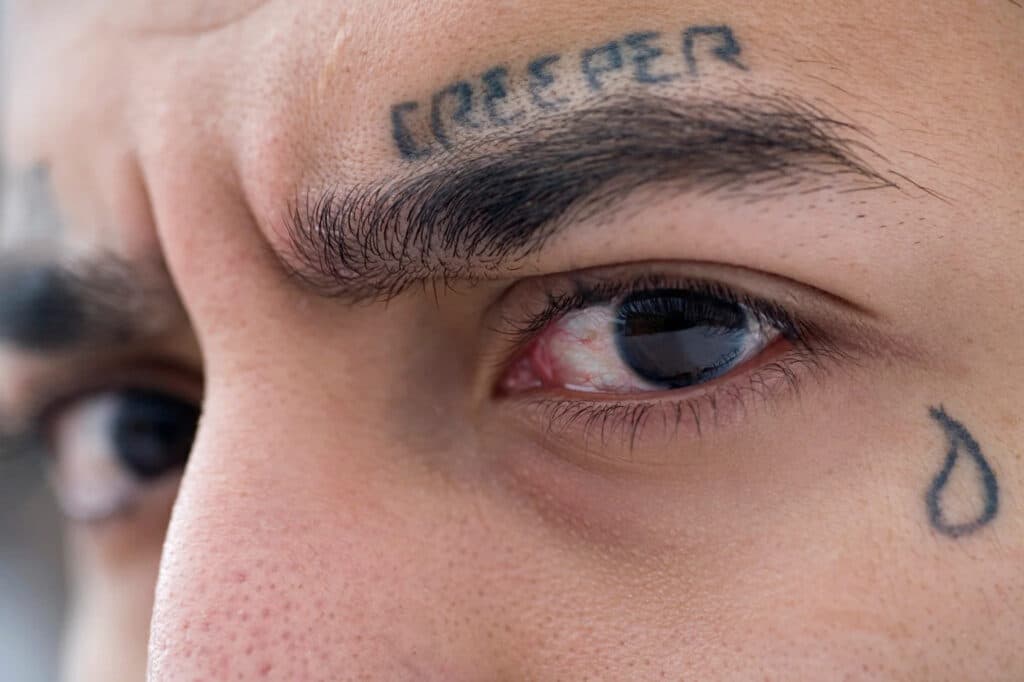Featured image credit: Dictionary.com
In the intricate tapestry of body art, few designs stir as much intrigue and controversy as the teardrop tattoo.
A small, simple outline of a drop beneath the eye, this tattoo carries a weight far beyond its modest size. Historically enveloped in a cloak of mystery and dark connotations, the teardrop tattoo has been a symbol met with both curiosity and caution.
Its meanings are as varied as they are profound, often rooted in loss, sorrow, or the endurance of challenging times.
Yet, in some circles, misinterpretations abound, leading to widespread speculation about the wearer's past and intentions.
As we delve deeper into the origins and evolving perceptions of the teardrop tattoo, it's crucial to approach with an open mind and a readiness to confront the complexities of its symbolism.
This article aims to shed light on the multifaceted nature of this poignant emblem, navigating through its controversial aspects and the diverse interpretations it garners across different cultures and communities.
Warning: Please be advised that the following content will explore themes and narratives that some readers may find distressing. Reader discretion is advised as we proceed to unravel the intricate layers of meaning behind the teardrop tattoo.
What Does A Teardrop Tattoo Mean?
The history of the teardrop tattoo is as enigmatic as the design itself, steeped in a murky blend of folklore, prison culture, and street lore.
Its origins are difficult to pinpoint, with various narratives attributing its birth to different corners of the underworld.
This ambiguity has only fueled the tattoo's notoriety, making it a symbol shrouded in mystery and often, misunderstanding.
Traditionally, the teardrop tattoo is believed to have originated within the prison systems, where body art tells a story of personal history, affiliations, and life outside the bars.
Here, the teardrop has been variously interpreted to represent the loss of a loved one, the commitment of a crime, or the serving of a lengthy sentence.
The exact meaning can vary widely between different communities and individuals, adding layers of complexity to this simple design.
This uncertainty has not deterred the teardrop tattoo from making its mark beyond the prison walls and into the broader public consciousness. The mystique surrounding its true meaning has, paradoxically, become part of its allure.
In some cases, this has led individuals with no ties to criminal activity to adopt the teardrop tattoo, drawn to the false sense of notoriety and toughness it might convey.
This trend is a testament to the powerful role of ambiguity and symbolism in body art, where the desire to project a certain image can sometimes outweigh the understanding of a symbol's roots.
However, the decision to wear a teardrop tattoo is not without its risks. Given its associations with crime and loss, sporting such a tattoo can lead to misinterpretations and judgments from others, particularly from those familiar with its darker connotations.
The allure of a perceived 'edge' must be weighed against the potential for misunderstanding and the unintended messages it may send.
As we peel back the layers of the teardrop tattoo's history, we uncover a complex tapestry of human emotion, from grief and regret to a desire for respect and recognition.
The teardrop's journey from the shadowy depths of prison culture to mainstream visibility underscores the evolving nature of tattoo symbolism and the enduring fascination with the stories our bodies can tell.
The teardrop tattoo's narrative takes a darker turn when delving into its connections with gang violence and criminal activities.
Among its various interpretations, the most unsettling link the tattoo to acts of violence, such as murder. In some gang cultures, it's rumored that a teardrop below one's eye signifies having taken a life, serving as a chilling badge of violent deeds.
This association has contributed significantly to the tattoo's notoriety and the apprehension it arouses in the public consciousness.
While less commonly discussed, there are also instances where the teardrop tattoo is believed to represent a history of sexual assault or other grave offenses.

Photo via Corrections1
These interpretations, however, are deeply mired in the complex codes and signals of gang affiliations and prison hierarchies, where tattoos often serve as a non-verbal language of experiences and ranks.
It's crucial to acknowledge the profound impact these associations can have, not only on the individuals bearing the tattoo but also on the communities around them.
The teardrop tattoo, when linked to such grave acts, perpetuates a cycle of stigma and fear, reinforcing stereotypes around body art and those who choose to wear it.
This stigma can overshadow the personal, non-violent meanings the tattoo may hold for some, turning it into a symbol of alienation.
The connection between the teardrop tattoo and acts of violence serves as a stark reminder of the power of symbols and the importance of understanding the cultural and personal narratives they carry.
It underscores the need for a nuanced perspective when interpreting tattoos, recognizing that the lines between personal expression and cultural symbols can often blur.
Designs and Colours of the Teardrop Tattoos
Despite its seemingly straightforward design, the teardrop tattoo boasts a surprising range of variations that reflect the wearer's personal story, artistic taste, or the cultural significance attributed to the symbol.
From subtle outlines to bold, filled-in designs, each variation of the teardrop tattoo adds a layer of depth and individuality to this iconic symbol.
Designs and Styles
Outline vs. Solid
The most traditional form of the teardrop tattoo is a simple outline, suggesting a more subdued or personal meaning.
In contrast, a solid or filled-in teardrop can indicate a stronger, more definitive statement, often associated with the more somber aspects of the symbol's history.
Placement
While traditionally placed under the eye, modern interpretations see the teardrop appearing in different locations, such as near the collarbone or on the wrist, each offering a new context and meaning.
Size
The size of a teardrop tattoo can vary, from small and discreet to larger and more noticeable, depending on the individual's preference and the statement they wish to make.
Colors and Variations
- Black: The most common color for teardrop tattoos, black, signifies the traditional meanings associated with mourning, loss, or remembrance.
- Blue: A less common variation, a blue teardrop, can symbolize sadness or depression, adding an emotional depth to the tattoo's significance.
- Clear or No Color: Some choose a clear or outline-only teardrop to represent an attempted crime or loss, leaving the interpretation open and more personal.
In some instances, wearers choose to add elements to the teardrop, such as names, dates, or other symbols, to further personalize the tattoo and deepen its meaning.
These additions can transform the teardrop from a standalone symbol to a more complex narrative piece, telling a story unique to the wearer.
Various teardrop tattoo Ideas
Depending on what the teardrop means to different individuals, they get a teardrop tattoo of various designs.
Below is a list of the various designs of teardrop tattoos and their respective meaning.
Single teardrop tattoo design
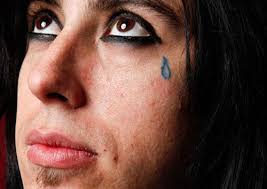
Photo by Art With Kate | Medium
A single teardrop design tattoo is a little or medium-sized single teardrop tattoo placed under one eye.
In this style, the teardrop may be filled and may have a little tattoo of a cross or sword to it symbolizing the loss of something.
Colored teardrop tattoo design
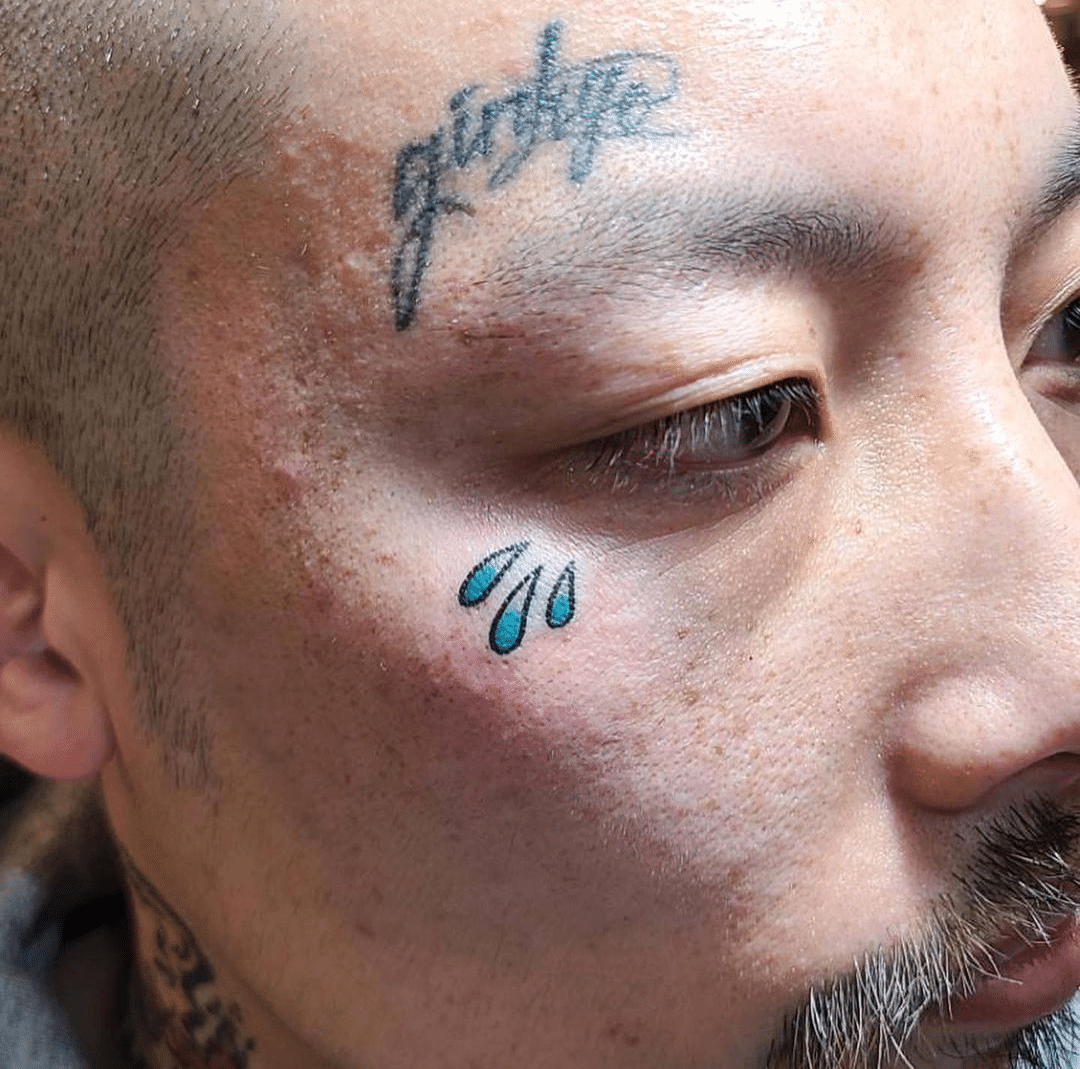
Photo via IG @garret_clothing
Introducing color into the teardrop tattoo can significantly alter its perception. For example, a blue teardrop might symbolize sadness or melancholy, while a red one could represent love and passion lost.
The choice of color can transform the tattoo's meaning, making it deeply personal and unique to the wearer.
Filled in with solid ink teardrop tattoo design

Photo via Quora
A solid ink-filled-in teardrop tattoo design is rumored to signify a committed murder that has been committed. A filled-in teardrop could portray a search for retaliation and vengeance.
Outline teardrop tattoo design
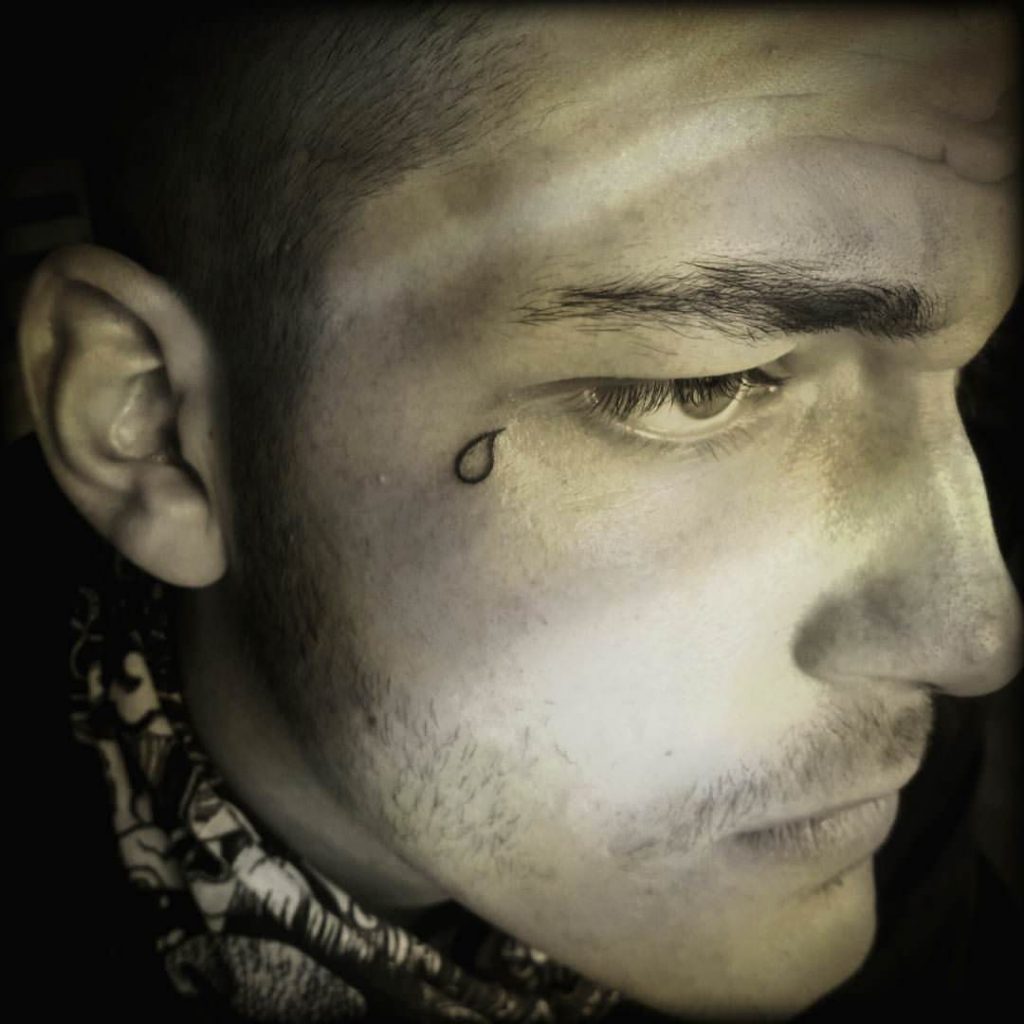
Photo via AuthorityTattoo
A teardrop tattoo with only the outline indicates that the murder was only partially committed by the person.
In other situations, just an outline tear tattoo could also be connected to a deceased friend or gang member.
Upside-down teardrop tattoo design
This design hints that the individual that has the tattoo has experience with incarceration and signifies that the person was humiliated while he was serving his sentence. It is upside down because the owner wants to hide shame or humiliation.
Multiple teardrop tattoo design

Photo via Medium
Multiple teardrop tattoos can be placed in either a specific pattern or randomly throughout the region that is in focus like the eye.
Each teardrop can be either clear or inked and signifies hardships and challenges.
Alternative Teardrop Tattoo Designs
Teardrop Tattoo on the Wrist or Ankle
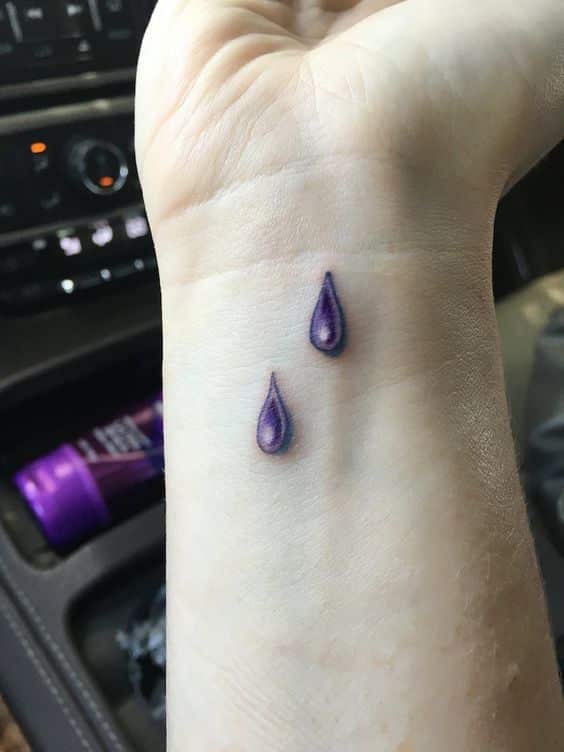
Image source: prince.org
When placed on the wrist or ankle, a teardrop tattoo can symbolize a moment of sadness or loss that has touched one's life, serving as a discreet yet powerful reminder of personal resilience and the capacity to move forward.
Teardrop as Part of a Larger Design
Integrating a teardrop into a larger, more complex tattoo can soften its traditional associations.
For instance, a teardrop within a floral arrangement or as part of a water-themed design can represent renewal, life, and the natural flow of emotions.
Abstract or Stylized Teardrops
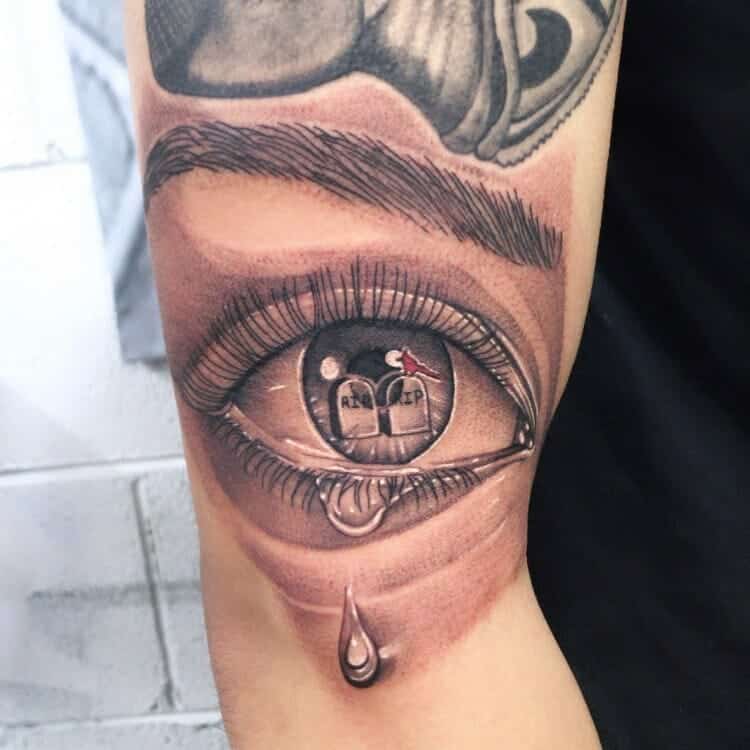
Image source: Outsons
Moving away from the realistic depiction, abstract or stylized teardrops can offer a more artistic take, focusing on the aesthetic form rather than the symbol's historical baggage.
These designs can play with shapes, lines, and curves, presenting the teardrop as a motif of artistic expression rather than a direct symbol of sorrow or loss.
Teardrops in Unconventional Places
Placing a teardrop in less common areas, such as behind the ear, on the shoulder, or even on a finger, can detach the symbol from its traditional connotations.
In these new contexts, the teardrop can take on a range of personal meanings, from commemorating a moment of transformation to simply appreciating the beauty of tears as a part of human emotion.
By exploring teardrop tattoos outside their traditional placement beneath the eye, individuals can reclaim and reinterpret this powerful symbol in ways that resonate with their personal stories and aesthetic preferences.
This creative freedom allows the teardrop tattoo to evolve, reflecting a broader spectrum of human experiences and emotions beyond its controversial origins.
Frequently Asked Questions
What is the best spot for the teardrop tattoo?
The teardrop tattoo should be best tattooed on the face, preferably near the eyes, as its name suggests.
Teardrop tattoos on other body parts aside from the face would be more appropriately described as a waterdrop rather than a teardrop.
Do only people from prison get teardrop tattoos?
No, nothing prevents you from obtaining a teardrop tattoo even though prisoners are the ones that commonly have one. The teardrop tattoo is typically used to represent one’s struggles.
Is getting a teardrop tattoo bad?
Not really, it depends on the reason for your choice of tattoo and the emotions you want to symbolize.
Final Thoughts – Teardrop tattoo meaning
As we've journeyed through the intricate world of teardrop tattoos, from their murky origins and controversial associations to the diverse designs and placements beyond the traditional under-eye spot, it's clear that this simple symbol carries a complex spectrum of meanings.
For those considering adorning their skin with this potent emblem, it's crucial to understand the depth of its significance and the varied interpretations it may invoke in different circles.
The teardrop tattoo, while often associated with sorrow, loss, or even darker tales of violence, doesn't always carry a dangerous or somber message.
In the realm of body art, where personal expression and symbolism intertwine, the teardrop can also represent survival, resilience, or the marking of a significant life event.
It's a reminder that the language of tattoos is rich and multifaceted, where each drop of ink tells a unique story.
For the curious observer, the teardrop tattoo serves as a testament to the transformative power of tattoos, from a mark of notoriety to a symbol of profound personal meaning.
It highlights how body art can transcend its origins, adapting and evolving with each individual who wears it.
While some may choose the teardrop for its edgy allure, devoid of any personal connection to its traditional connotations, it's a decision that should not be taken lightly, given the weight of its history and potential for misinterpretation.
In the end, whether you're drawn to the teardrop tattoo for its aesthetic appeal, its rich symbolism, or simply out of curiosity, it's a choice that warrants careful consideration.
In the diverse language of tattoos, where each mark tells a story, the teardrop stands out as a symbol of the human experience in all its complexity—embracing joy, sorrow, and the myriad shades in between.
You might also be interested in these tattoo ideas:
- Kristen Bell Tattoos - July 15, 2024
- Risks of Tattooing - July 3, 2024
- Early Tattooing Methods - June 22, 2024

